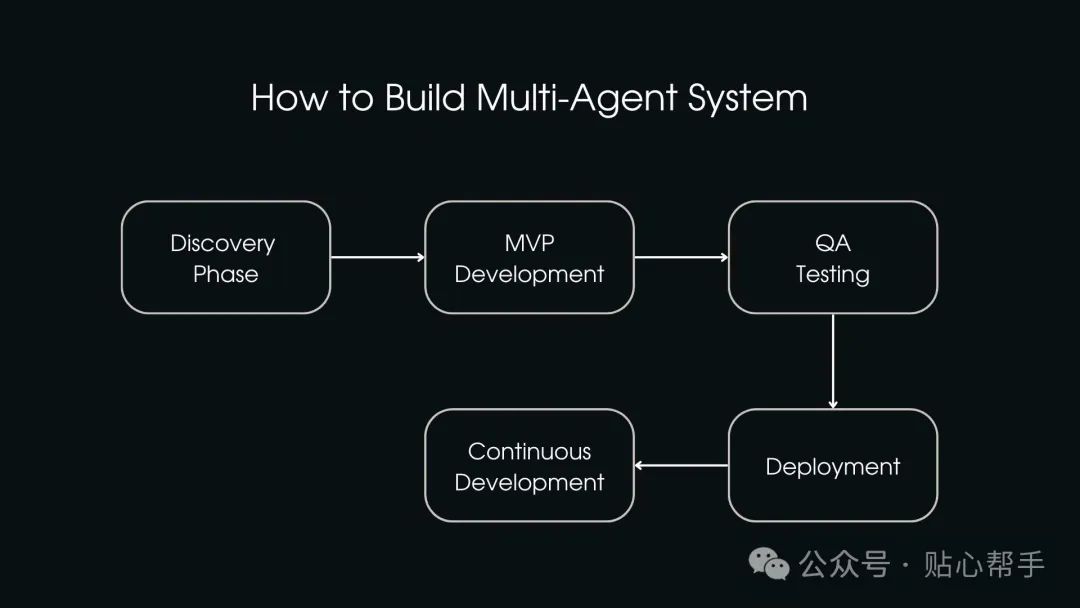With the rapid development of artificial intelligence technology, Multi-Agent AI systems are gradually becoming a key force driving business innovation and efficiency improvement. In this article, we will delve into the concept of Multi-Agent AI systems, the steps to build them, the choice of technology stack, and why they are the trend of the future in AI.

The Concept of Multi-Agent AI Systems
A Multi-Agent AI system is a network composed of multiple independent but collaboratively working AI Agents. Each Agent has specific roles and tasks, such as data collection, content generation, or quality review. These Agents work together to complete complex tasks through effective communication and coordination mechanisms. The core of Multi-Agent AI systems lies in their distributed and modular design, allowing the system to flexibly respond to various complex scenarios.
Characteristics of Multi-Agent AI Systems
- Modular Design: Each Agent focuses on a specific task, making the system easy to maintain and expand.
- Collaborative Work: Agents complete tasks together through communication protocols and coordination mechanisms.
- Adaptive Capability: Multi-Agent systems can dynamically adjust the behavior and strategies of Agents based on environmental changes and task requirements.
- Fault Tolerance: Since tasks are distributed among multiple Agents, the failure of a single Agent will not cause the entire system to crash.
Steps to Build a Multi-Agent AI System
Building an efficient Multi-Agent AI system requires several key steps:
Step 1: Discovery Phase
In this phase, we need to clarify the project’s problems and business objectives, determine the roles of the Agents, and map out the interactions between them. For example, in a content automation system, a research Agent is responsible for data collection, a writing Agent generates drafts, and a review Agent ensures quality.
- Problem Definition: Clearly define the core problems and business objectives that the system aims to solve.
- Role Assignment: Determine the roles and responsibilities of each Agent based on task requirements.
- Interaction Design: Design the communication protocols and data exchange methods between Agents.
Step 2: MVP Development
Start by building 2-3 core Agents, defining clear roles to avoid overlap, and ensuring smooth data exchange between Agents. For example, in a product recommendation AI system, one Agent analyzes customer behavior while another Agent personalizes suggestions.
- Core Agent Development: Select the most critical tasks and develop the corresponding Agents.
- Role Definition: Ensure that each Agent’s responsibilities are clear to avoid functional overlap.
- Data Flow Design: Design the data exchange mechanisms between Agents to ensure smooth information transfer.
Step 3: Agent Coordination
Agents need an effective communication process, which can be sequential, hierarchical, or parallel. Choosing the right structure can enhance efficiency and scalability.
- Communication Protocol: Choose appropriate communication protocols, such as HTTP, WebSocket, or message queues.
- Coordination Mechanism: Design coordination mechanisms between Agents, such as task allocation and conflict resolution.
- Structure Selection: Select the appropriate system structure based on task requirements, such as sequential, hierarchical, or parallel.
Step 4: Testing and Iteration
Before scaling, it is essential to rigorously test the communication and accuracy between Agents, conduct redundancy checks to avoid errors, and perform prompt engineering to optimize Agent responses.
- Communication Testing: Test whether communication between Agents is smooth and whether data is accurately transmitted.
- Redundancy Check: Design redundancy mechanisms to ensure that the failure of a single Agent does not affect the entire system.
- Prompt Engineering: Optimize the prompts and responses of Agents to improve the accuracy and efficiency of the system.
Step 5: Deployment and Scaling
Once testing is complete, integrate APIs and automation tools, databases, and knowledge bases, as well as large language models. Adding human supervision helps maintain quality control.
- API Integration: Integrate external APIs and automation tools to expand system functionality.
- Database and Knowledge Base: Establish databases and knowledge bases to support data storage and retrieval for Agents.
- Human Supervision: Introduce human supervision mechanisms to ensure quality control of the system.
Choosing the Technology Stack
Choosing the right technology stack is crucial when building Multi-Agent AI systems. Here are some commonly used technologies and tools:
- Large Language Models (LLMs): DeepSeek, GPT-4, Claude, Mixtral
- Frameworks: LangChain, AutoGPT, CrewAI, LlamaIndex
- Orchestration: Python, Node.js, FastAPI
- Automation: Zapier, Airflow
- Data Processing: Pinecone, Weaviate
Considerations for Technology Stack Selection
- Task Requirements: Choose appropriate technologies and tools based on the system’s task requirements.
- Scalability: Select a technology stack that can support system scalability.
- Usability: Choose a technology stack that is easy to develop and maintain.
- Community Support: Select a technology stack with active community support for problem-solving and resource acquisition.
Why Multi-Agent AI is the Future
Multi-Agent AI systems have several significant advantages:
- Handling Complex Tasks: Modular AI Agents handle complex tasks.
- Reducing Errors: Cross-Agent validation reduces AI errors.
- Scalability: Scalability is achieved by adding new Agents.
- Automating Business Operations: Large-scale automation of business operations.
Application Scenarios of Multi-Agent AI
- Intelligent Customer Service: Multiple Agents work together to handle customer inquiries, complaints, and suggestions.
- Intelligent Manufacturing: Agents collaborate to control production lines and optimize production processes.
- Financial Risk Control: Multiple Agents analyze financial data collaboratively to identify risks.
- Medical Diagnosis: Agents analyze medical data collaboratively to provide diagnostic suggestions.
Conclusion
The future of AI is not a single large model, but a network composed of multiple collaborating Agents. Multi-Agent AI systems provide unprecedented flexibility and efficiency for businesses through modularity, scalability, and automation. As technology continues to advance, we have reason to believe that Multi-Agent AI will play an increasingly important role in the future.
Through this article, we hope you gain a comprehensive understanding of Multi-Agent AI systems and recognize their potential in driving business innovation and efficiency improvement. As technology continues to evolve, Multi-Agent AI systems will become an important trend in the AI field, bringing us more possibilities and opportunities.